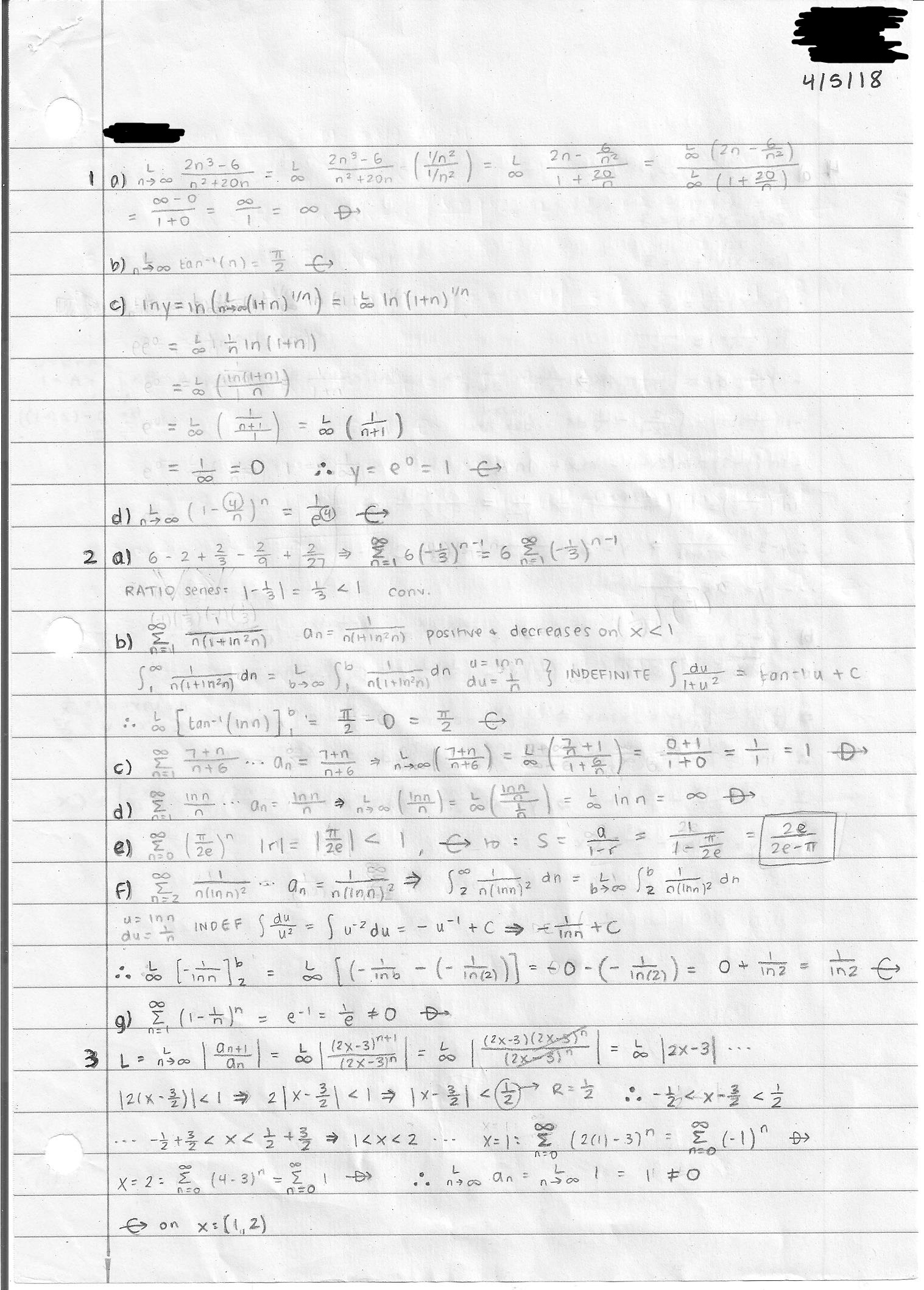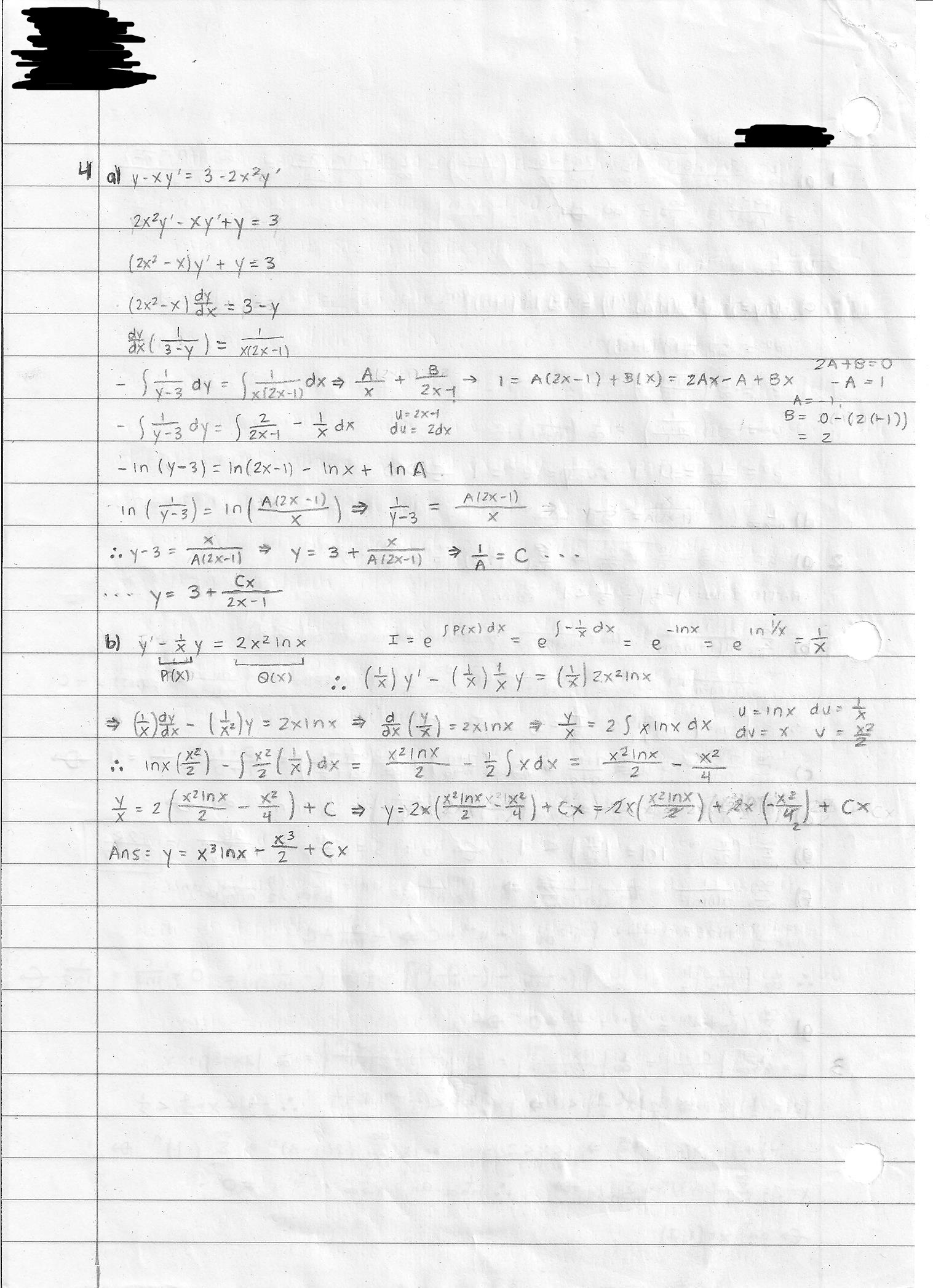Series and sequences?
This is for self-reference ( I will be answering it ).
Feel free to edit if you want to correct anything, though.
-
Determine if the following sequences are convergent or divergent.
a) a_n=(2n^3-6)/(n^2+20n)
b) a_n=\tan^-1(n)
c) a_n=(1+n)^(1/n)
d) a_n=(1-4/n)^n
-
Determine if the following series are convergent or divergent. Use the appropriate test and check all the conditions.
a) 6-2+2/3-2/9+2/27-2/81+...
b) \sum_(n=1)^\infty1/(n(1+\ln^2n))
c) \sum_(n=1)^\infty(7+n)/(n+6)
d) \sum_(n=1)^\infty\ln(n)/n
e) \sum_(n=0)^\infty(\pi/(2e))^n
f) \sum_(n=2)^\infty1/(n(\ln(n))^2
g) \sum_(n=1)^\infty(1-1/n)^n
-
Find the values of x of which the following series is convergent.
\sum_(n=0)^\infty(2x-3)^n
-
Solve the following differential equations.
a) y-xy'=3-2x^2y'
b) y'-1/xy=2x^2\ln(x)
This is for self-reference ( I will be answering it ).
Feel free to edit if you want to correct anything, though.
-
Determine if the following sequences are convergent or divergent.
a)a_n=(2n^3-6)/(n^2+20n)
b)a_n=\tan^-1(n)
c)a_n=(1+n)^(1/n)
d)a_n=(1-4/n)^n -
Determine if the following series are convergent or divergent. Use the appropriate test and check all the conditions.
a)6-2+2/3-2/9+2/27-2/81+...
b)\sum_(n=1)^\infty1/(n(1+\ln^2n))
c)\sum_(n=1)^\infty(7+n)/(n+6)
d)\sum_(n=1)^\infty\ln(n)/n
e)\sum_(n=0)^\infty(\pi/(2e))^n
f)\sum_(n=2)^\infty1/(n(\ln(n))^2
g)\sum_(n=1)^\infty(1-1/n)^n -
Find the values of
x of which the following series is convergent.
\sum_(n=0)^\infty(2x-3)^n -
Solve the following differential equations.
a)y-xy'=3-2x^2y'
b)y'-1/xy=2x^2\ln(x)
1 Answer
-
a)
\infty , divergent
b)\pi/2 , convergent
c)1 , convergent\color(red)(♦)
d)1/e^4 , convergent -
a)
r\lt1 , convergent\color(red)(♦)
b)\pi/2 , convergent
c)1 , divergent
d)\infty , divergent
e) convergent to(2e)/(2e-\pi)
f)1/\ln(2) , convergent
g)1/e\ne0 , divergent -
convergent on
1\ltx\lt2 \color(red)(♦) -
a)
y=3+x/(A(2x-1)) ORy=3x+(Cx)/(2x-1) \color(red)(♦)
b)y=x^3\lnx-x^3/2+Cx \color(red)(♦)
Explanation:
- For 1c, thanks to Steve M.
- For 2a, thanks to Parabola
- For 3, thanks to VNVDVI
- For 4a, thanks to Steve M.
- For 4b, thanks to Steve M.
 computer
computer
 computer
computer

